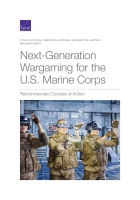by Yuna Huh Wong, Sebastian Joon Bae, Elizabeth M. Bartels, Benjamin Smith
 What characteristics of other wargaming centers might be of use to the Marine Corps as it invests in its wargaming capability?
What characteristics of other wargaming centers might be of use to the Marine Corps as it invests in its wargaming capability?
Which practices, tools, and approaches might be useful to the Marine Corps, and how can they be adapted to suit Marine Corps needs?
What courses of action should the Marine Corps take toward building its next-generation wargaming concept?
The U.S. Marine Corps has an opportunity not only to adopt wargaming best practices, tools, and approaches from other sources but also to adapt and develop them further to suit its own needs. This report is designed to help the Marine Corps understand the utility of different wargaming tools as the service invests in its wargaming capability and in building its next-generation wargaming concept. The authors have collected information on wargaming processes, facilities, and skill sets through research and interviews at various wargaming centers. They identify tasks by wargaming type in order to provide information on when in the wargaming process certain tools might be useful.
The authors make recommendations for low-, medium-, and high-resourced courses of action (COAs), with the COAs meant to build on each other rather than representing choices between discrete options. The low-resourced COA involves actions that can be implemented with minimal resources and relatively quickly, focusing on improving processes and the wargaming skills of staff already engaged. The medium-resourced COA builds on the previous one, featuring recommendations that require more resources, time, and research and that involve a greater degree of uncertainty, focusing on acquiring additional skill sets, personnel, and equipment. The high-resourced COA builds on the two previous COAs and requires major reorganization or changes in policy or actions of inherent high complexity and financial commitment, focusing on the construction of new and specialized wargaming facilities.
Key Findings
A number of major themes arose in interviews at wargaming centers
Centers support wargaming for a variety of purposes and employ a wide range of tools, approaches, adjudication methods, and skill sets.
Centers employ a mixture of wargame designers, military operators, analysts, social scientists, programmers, and information technology support.
There is continual exploration of new commercial software and tools and further development of government off-the-shelf or custom-built software.
Facilities and their configurability were a key aspect of discussions at wargaming centers
Some centers do not own any facilities aside from shared conference rooms or classrooms, while others possess elaborate infrastructure (such as a dedicated building or auditorium, configurable gaming rooms, server rooms, or video studios).
Adaptability and flexibility are paramount, and all of the centers emphasized the importance of the configurability of facilities.
Several characteristics define the state of the art of wargaming
The adoption of technology in defense wargaming is considerably lower than in the commercial gaming world, in part because government security issues pose significant barriers to the use of commercial games.
In a drive toward systemization, centers are paying more attention to methodical, transparent approaches to gaming in the hope of generating more-credible insights.
Innovations to support positive player experience, such as video, touch panels, or three-dimensional projections, are a hallmark of state-of-the-art games.
Wargaming center members stressed that games had the most impact when embedded in a series of games, a cycle of research, or other broader processes.
Recommendations
Continue Marine Corps–level integration of wargaming with capability development and programmatic decisionmaking.
Focus on quick-turn games that can explore issues in a responsive way by leveraging small groups and flexible game designs.
Bring in additional resources to support innovative gaming, including materials to create new board games or modify existing ones.
Create a government-off-the-shelf ecosystem, experimenting with and adapting different tools for Marine Corps purposes.
Provide formal wargaming education to staff on design methodology, styles, and adjudication.
Share information and collaborate with other organizations.
Establish and expand a network of experts, including university faculty and subject-matter experts, research centers, and think-tanks.
Bring in additional staff with expertise in software development or programming; information technology and network support; operations research, social science, or other analytical backgrounds; and wargame design.
Add staff and equipment for multiple networks, including a stand-alone network that is dedicated to wargaming use only.
Give staff time to further develop existing tools and to research and prototype new gaming constructs.
Provide Top Secret clearances for staff in order to support events at this higher level of classification.
Add commercial tools for knowledge management, data capture, analysis, video creation, and graphic design.
Buy a large-format printer to create maps and visuals.
Consider the highest level of classification that the Marine Corps desires as it builds new wargaming spaces.
Build flexible spaces with configurable seating, tables, walls, networks, and audiovisual equipment.
Create workspaces for teams apart from spaces for wargame participants.
Furnish a reference library.
No comments:
Post a Comment